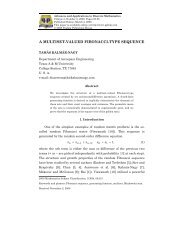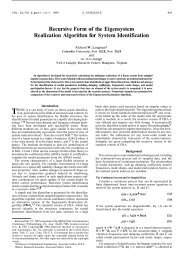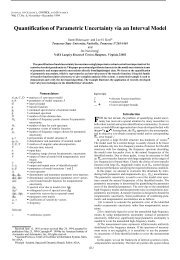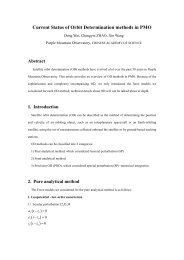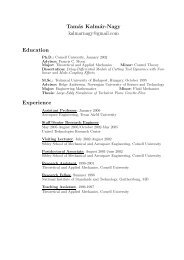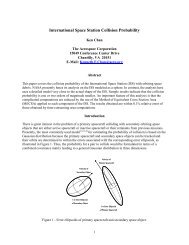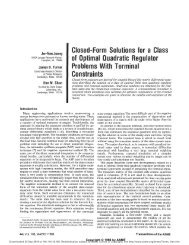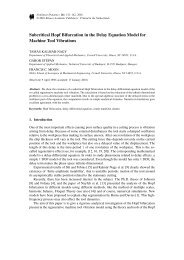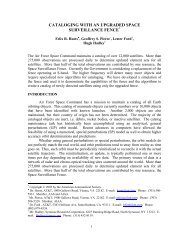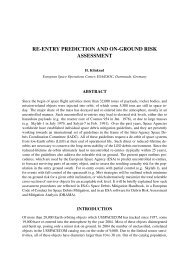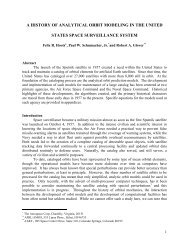Observer/Kalman-Filter Time-Varying System Identification - AIAA
Observer/Kalman-Filter Time-Varying System Identification - AIAA
Observer/Kalman-Filter Time-Varying System Identification - AIAA
Create successful ePaper yourself
Turn your PDF publications into a flip-book with our unique Google optimized e-Paper software.
890 MAJJI, JUANG, AND JUNKINS<br />
not change with the discrete-time step t k . In fact, it is observed that a<br />
minimum of Nexp min r p r m experiments are necessary<br />
to determine the observer Markov parameters uniquely. From the<br />
developments of the subsequent sections, this is the minimum<br />
number of repeated experiments one should perform in order to<br />
realize the time-varying system models desired from the TVERA.<br />
Equation (17), with N repeated experiments, yields:<br />
Y k y 1<br />
k y 2<br />
k ... y N<br />
k<br />
2<br />
3<br />
u 1<br />
k u 2<br />
k u N<br />
k<br />
v 1<br />
k 1 v 2<br />
k 1 v N<br />
k 1<br />
D k h k;k 1 h k;k 2 ... h k;k p<br />
v 1<br />
k 2 v 2<br />
k 2 ... v N<br />
k 2<br />
.<br />
.<br />
. . 6<br />
7<br />
4<br />
5<br />
v 1<br />
k p v 2<br />
k p v N<br />
k p<br />
M k V k (18)<br />
8 k>p. Therefore, the least-squares solution for the generalized<br />
observer Markov parameters is given for each time step as<br />
^M k Y k V † k (19)<br />
where : † denotes the pseudoinverse of a matrix [15,16]. The<br />
calculation of the system Markov parameters and the observer gain<br />
Markov parameters is detailed in the next section.<br />
IV. Computation of Generalized <strong>System</strong> Markov<br />
Parameters and <strong>Observer</strong> Gain Sequence<br />
We first outline a process for the determination of a system Markov<br />
parameter sequence from the observer Markov parameter sequence<br />
calculated in the previous section. A recursive relationship is then<br />
given to obtain the system Markov parameters, with the index<br />
difference of greater than p time steps. Similar procedures are set up<br />
for observer gain Markov parameter sequences.<br />
A. Computation of <strong>System</strong> Markov Parameters from <strong>Observer</strong><br />
Markov Parameters<br />
Considering the definition of the generalized observer Markov<br />
parameters, we write<br />
h k;k 1 C k B k 1<br />
C k B k 1 G k 1 D k 1 G k 1<br />
h 1<br />
k;k 1 h 2<br />
k;k 1<br />
(20)<br />
where the superscripts in Eqs. (1) and (2) are used to distinguish<br />
between the Markov parameter sequences useful to compute the<br />
system parameters and the observer gains, respectively. Observe the<br />
following manipulation, written as<br />
h 1<br />
k;k 1 h 2<br />
k;k 1 D k 1 C k B k 1 h k;k 1 (21)<br />
A similar expression for Markov parameters with two time steps<br />
between them yields:<br />
h 1<br />
k;k 2<br />
h 2<br />
k;k 2 D k 2 C k A k 1 B k 2 C k A k 1 G k 2 D k 2<br />
C k A k 1 B k 2 G k 2 D k 2 C k A k 1 G k 2 D k 2<br />
C k A k 1 B k 2<br />
C k A k 1 G k 1 C k 1 B k 2<br />
C k A k 1 B k 2 h 2<br />
k;k 1 C k 1B k 2<br />
h k;k 2 h 2<br />
k;k 1 h k 1;k 2 (22)<br />
This elegant manipulation leads to an expression for the system<br />
Markov parameter h k;k 2 to be calculated from observer Markov<br />
parameters at the time step t k and the system Markov parameters at<br />
previous time steps. This recursive relationship was found to hold in<br />
general and enables the calculation of the system Markov parameters<br />
(unadorned h i;j ) from the observer Markov parameters h i;j .<br />
To show this holds in general, consider the induction step<br />
with the observer Markov parameters (with p time-step separation)<br />
given by<br />
h 1<br />
k;k p h 2<br />
k;k p D k p C k A k 1 ; A k 2 ; ...; A k p 1 B k p G k p D k p<br />
C k A k 1 ; A k 2 ; ...; A k p<br />
C k A k 1 ; A k 2 ; ...; A k p<br />
1 G k p D k p<br />
1 B k p<br />
C k A k 1; A k 2 ; ...; A k p 2 A k p 1 G k p 1 C k p 1 B k p<br />
C k A k 1 ; A k 2 ; ...; A k p 2 ;A k p 1 B k p<br />
C k A k 1 ; A k 2 ; ...; A k p 2 G k p 1 C k p 1 B k p<br />
C k A k 1 ; A k 2 ; ...; A k p 2 A k p 1 B k p<br />
h 2<br />
k;k p 1 h k p 1;k p (23)<br />
Careful examination reveals that the term<br />
can be written as<br />
C k A k 1 ; A k 2 ; ... ; A k p 2 ; A k p 1 B k p<br />
C k A k 1 ; A k 2 ; ... ; A k p 2 ;A k p 1 B k p<br />
C k A k 1 ; ... ; A k p 3 A k p 2 G k p 2 C k p 2 A k p 1 B k p<br />
C k A k 1 ; ... ;A k p 2 ;A k p 1 B k p<br />
C k A k 1 ; ... ;G k p 2 C k p 2 A k p 1 B k p<br />
C k A k 1 ; ... ;A k p 2 ;A k p 1 B k p h 2<br />
k;k p 2 h k p 2;k p<br />
.<br />
C k A k 1 ; ... ;A k p 1 B k p h 2<br />
k;k 1 h k 1;k p<br />
h 2<br />
k;k 2 h k 2;k p h 2<br />
k;k p 2 h k p 2;k p<br />
h k;k p h 2<br />
k;k 1 h k 1;k p h 2<br />
k;k 2 h k 2;k p<br />
h 2<br />
k;k p 2 h k p 2;k p (24)<br />
This manipulation enables us to write<br />
h 1<br />
k;k p h 2<br />
k;k p D k p<br />
h k;k p h 2<br />
k;k 1 h k 1;k p h 2<br />
k;k 2 h k 2;k p<br />
h k;k p<br />
X p 1<br />
h 2<br />
k;k p 1 h k p 1;k p<br />
j 1<br />
h 2<br />
k;k j h k j;k p (25)<br />
Writing the derived relationships between the system and the<br />
observer Markov parameters yields the following set of equations:<br />
h k;k 1 h 1<br />
k;k 1 h 2<br />
k;k 1 D k 1;<br />
h k;k 2 h 2<br />
k;k 1 h k 1;k 2 h 1<br />
k;k 2<br />
h 2<br />
k;k 2 D k 2<br />
.<br />
h k;k p h 2<br />
k;k 1 h k 1;k p h 2<br />
k;k p 1 h k p 1;k p<br />
h 1<br />
k;k p h 2<br />
k;k p D k p (26)<br />
Defining r i;j<br />
: h 1<br />
i;j h 2<br />
i;j D j , we obtain the system of linear<br />
equations, relating the system and observer Markov parameters as





